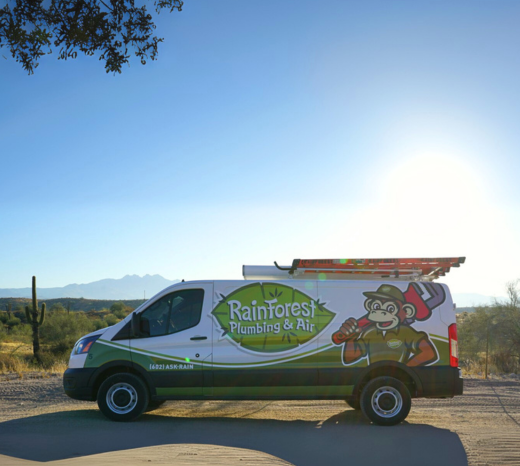In today’s blog our experienced technicians will go over everything you need to know about upgrading to a heat pump. From the importance to proper sizing, to efficiency and power needs, this blog has got you covered!

Phoenix’s weather is intense, and we’re very dependent on our air conditioning. Whether its a window unit or central AC, cooling systems our superheroes when things get too hot.
But what if you’re looking to upgrade your system, and perhaps your efficiency while you’re at it? You’ve probably heard a lot about heat pumps, the hot, not-so-new home comfort system on the block.
But are heat pumps powerful enough to heat your Phoenix area home? Let’s find out!
In today’s blog our experienced technicians will go over everything you need to know about upgrading to a heat pump. From the importance to proper sizing, to efficiency and power needs, this blog has got you covered!
Rainforest Plumbing & Air is Phoenix’s #1 choice for heat pump installation, repair and maintenance. Let’s dive in and see if a heat pump is the right fit for your needs.
How Does a Heat Pump Work?
Heat pumps offer an excellent solution for both heating and cooling residential and commercial properties. They operate with minimal energy consumption to generate heat, and their efficiency is enhanced by utilizing the same pump or compressor found in air conditioning units. These compact yet powerful units are highly dependable, require minimal maintenance, and represent a significant improvement to any home's HVAC system.
A heat pump operates by extracting heat from the outdoor environment (air, ground, or water) and compressing it to a higher temperature for indoor release, even in cold conditions. This process is reversed for cooling, where heat is extracted from the interior and released outside. This cycle is made possible by an outdoor unit (featuring a compressor and condenser coil) and an indoor unit (with an expansion valve and evaporator coil), which are connected by a refrigerant circuit.
Heat Pump vs. AC - What’s the Difference?
An AC unit is primarily designed for cooling. During warmer months, it works by absorbing heat from inside your home and expelling it to the outside. This process involves a refrigerant circulating through coils, absorbing heat from the indoor air, and then releasing that heat outside as the refrigerant changes pressure and temperature.
A heat pump, on the other hand, is a much more versatile system. While it operates on the same heat-transfer principle as an AC, it has a reversing valve that allows it to essentially reverse its function.
| Feature | Air Conditioner (AC) | Heat Pump |
| Primary Role | Cooling only | Heating and cooling |
| Seasonal Use | Summer/warm months (here in Phoenix, year round) | Year-round (both warm and cold seasons) |
| Energy Source | Primarily electricity for cooling | Electricity for both heating and cooling |
| Efficiency | Efficient for cooling | Highly efficient for both heating and cooling, especially in milder climates |
| Components | Indoor unit (evaporator coil), outdoor unit (condenser coil, compressor) | Same as AC, but with a reversing valve and often a supplemental heating element for colder conditions |
| Cost | Generally lower initial installation cost | Higher initial installation cost, but can offer long-term energy savings |
The dual functionality of heat pumps is what really sets them apart and makes them an increasingly popular choice for homeowners seeking comfort and energy savings.
That’s great and everything, but here in the desert, you don’t necessarily need or care about that functionality. What you do really care about is if it’s powerful enough to tackle our 100 degree days. Let’s explore more below.
Are Heat Pumps Effective in Hot Climates?
Modern heat pumps have come a long way since they were first introduced, transforming them into highly efficient and reliable systems for cooling.
Things like compressor design, refrigerant types, and smart controls have greatly improved their performance in various climates, including extreme desert environments. These advancements allow heat pumps to extract and transfer heat more effectively, providing consistent cooling comfort while consuming less energy.
Just like your traditional air conditioning unit, heat pump efficiency is measured by SEER.
Also known as Seasonal Energy Efficiency Ratio or Rating, SEER is a crucial metric for determining the cooling efficiency of your heat pump. While traditional AC units have SEER ratings of 13-14, a heat pump can often have SEER ratings of 20 or higher. Meaning they provide powerful cooling, while using less energy. Leading to substantial savings on your monthly bills.
No matter how powerful the heat pump in your home, it will still need a little helping hand here and there, to keep you comfortable during the desert summers. And the best way to do this is with regular maintenance and cleaning. Especially because of the increased risk of dust and sand getting into the coils and other interior components of your heat pump, greatly reducing air flow and its cooling power.
The Importance of Proper Installation From Rainforest Plumbing & Air
Professional installation is absolutely key to ensuring your heat pump can handle our hot climate. So choose Rainforest Plumbing & Air for enhanced peace of mind.
When you schedule your heat pump installation, a skilled technician will visit your home to begin the evaluation. This assessment includes:
- Home Size & Usage: Your technician will assess your home's dimensions and estimate usage to recommend the best options.
- Thorough Measurements: Precise measurements of your home's square footage, doors, and windows will be taken.
- System Inspection: Vents and ducts will be inspected for any clogs or damage that could affect the heat pump's performance.
Following the evaluation, you will receive a personalized, comprehensive quote tailored to your home's specific heating and cooling requirements.
This extra attention to sizing, ensures your heat pump can handle our extreme temperature fluctuations without running constantly, increasing your utility bills and even leading to premature repairs and breakdowns.
Once you’ve chosen your heat pump option, your personal technician will show up at the predetermined installation time, and will install your new equipment within 3-4 hours, making sure to maintain a clean and orderly work space (wearing booties and laying down floor coverings) with minimal interruption to your day to day life.
Once the installation is complete, your technician will troubleshoot your new mini-split system to ensure any potential issues are addressed, and walk you through the operation and features of your new heat pump. Finally they will explain the manufacturer warranties.
And with Rainforest's Put Back Policy you can rest assured, when we clean up, we leave your space better than we found it, guaranteed!
When A Heat Pump Might Not Be Enough
If your heat pump is older or undersized it might not be enough to keep your home cool. If this is the case, a hybrid option combined with a high-efficiency AC unit might be the best option for you.
Not sure what you need, give our experienced and friendly team a call today!
Get High Powered, Cooling Convenience with a New Heat Pump Installation
If you’re ready to see if a heat pump can tackle your cooling needs, give us a call. We install a number of different kinds of heat pumps that are rated for the desert heat. Make the switch with Rainforest Plumbing & Air today!

Why Choose Rainforest Plumbing & Air? Service That Exceeds Expectation
Upfront Guarantee
We will never do any work until you know all the details so there are no surprises.
24/7 Emergency Service
Rest easy knowing that our skilled technicians are only a phone call away, day or night.
4.8 Star Rating on Google
We're proud to have 1000+ positive reviews on Google from satisfied customers in the Phoenix area.

